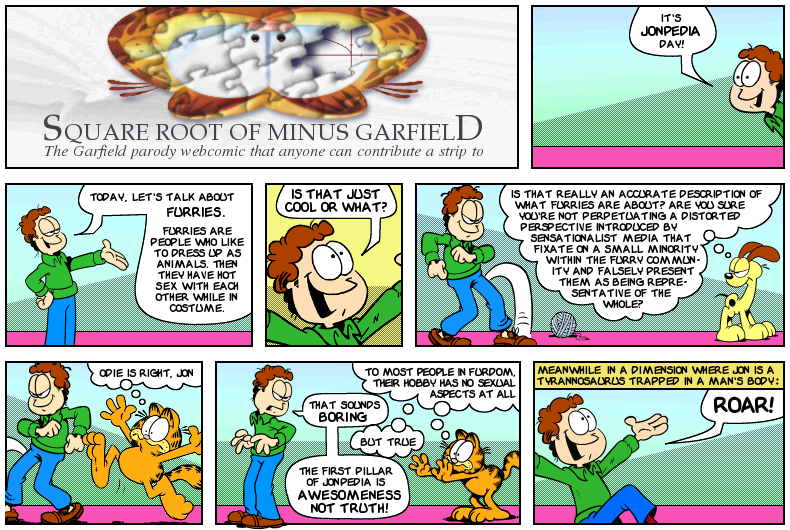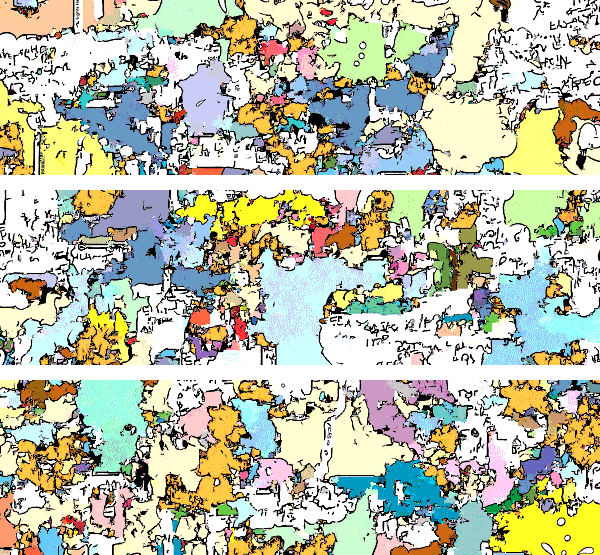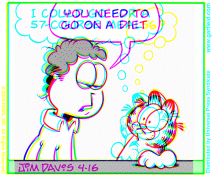I've always thought classical electrodynamics was a somewhat
mysterious thing.
Consider Maxwell's equations, in free space and natural units:
- ∇·E = ρ
- ∇·B = 0
- ∇×E = –∂B/∂t
- ∇×B = J + ∂E/∂t
where E and B are vector fields that respond to the
sources ρ (charge density scalar) and J (current density
vector) while also interacting with each other.
These equation tells us that (1) charge causes the electrical field to
diverge; (2) the magnetic field does not diverge (magnetic monopoles
do not exist); (3) a changing magnetic field causes the electric field
to curl; (4a) a current causes the magnetic field to curl; (4b) a
changing electric field works like a current.
With me so far? Good.
It is indisputable that these laws work; huge swaths of
practical engineering depend on them for their bread-and-butter.
But how can they work? Say that we turn on a current somewhere,
such that B starts to change. The
E-field feels this change and instantly rearranges itself
(globally!) such that its curl matches what the changing
B-field requires. But surely the E field will need to
change in order to achieve this. And the B-field will
need to respond to that, so the change of B we started out with
is not actually the right one, and so on ad infinitum... How do
the fields manage to obey the laws always and everywhere, no matter
how we shake the sources about? In other words, is Maxwell's theory
even internally consistent?
Only recently did I realize how easy it is to see that, yes, the theory
is in fact consistent. I feel a bit like a simpleton for not having
noticed this earlier – but I'm going to arrogantly assume that
some readers have had trouble seeing it too, and therefore would find
the following explanation interesting.
The trick is to reorder the terms in the equations slightly:
- ρ = ∇·E
- 0 = ∇·B
- ∂B/∂t = –∇×E
- ∂E/∂t = ∇×B – J
The two first equations are unchanged; they describe conditions on the
fields that hold at any frozen instant of time. But the two last
equations, rather than being formulas for finding the curls of
the fields, now describe how each field changes from time
t to t+δt, given the instantaneous values of the
fields and sources at time t.
In principle, if we know all of the sources, we can choose how the
fields are going to look at time t0, subject only to the
constraints of equations (1) and (2). Then we can use equations (3)
and (4) to evolve the fields as time passes, without anything
left for choice. (We can choose how the sources behave, of course; and
we can let the fields influence the motion of the sources through the
Lorentz force law, but that is no conceptual problem).
However, as we do this, we had better make sure that equations (1) and
(2) still hold at time t>t0.
Since there is no room for choice after
applying (3) and (4), this had better happen automatically – or
the theory really is inconsistent. Let's see what happens when
we differentiate (1) and (2), remembering that time and space
derivatives commute and then unfolding the LHS using (4) and (3):
- ∂ρ/∂t =
(&part/&partt)&nabla·E =
∇·(∂E/∂t) =
∇·(∇×B – J) =
∇·(∇×B) – ∇·J =
–∇·J
- 0 =
(&part/&partt)&nabla·B =
∇·(∂B/∂t) =
∇·(–∇×E) =
– ∇·(∇×E) =
0
The second equation dissolves into 0=0, so if only ∇×B=0
is true at t0, it will stay true forever. On the other hand,
the first equation becomes ∂ρ/∂t =
–∇·J, that is, charge conservation! To demand that
that ∇×E=ρ will stay true after t0
is exactly the same as to demand that charge is conserved.
The fact that Maxwell's equations imply charge conservation is well
known and can be found in textbooks. But now we also know that
any fields at t0 that have the right
divergences can be
extended to a solution of Maxwell's equations over all of
spacetime, simply by evolving with (3) and (4). (That is, unless we
worry about fields becoming infinite, which I don't at the moment.)
If the t0 fields do not have the curl we would expect from
electro- or magnetostatics given the sources at t0, this
simply means that some radiation was passing through the lab at
t0. The equations then tell us where that radiation
is going, and (running time backwards) where it came from.
So far, so good. But note that in our new perspective, the whys and
therefores of electrodynamics look somewhat different from the usual
presentation:
(1) the divergence of the electric field always points to the charges;
(2) the magnetic field never diverges;
(3) a curly electric field causes the magnetic field to change in the
opposite direction of the curl;
(4a) a curly magnetic field causes the electric field to change
in the direction of the curl;
(4b) a current causes the electric field to change in the opposite
direction of the current.
It's not that one field feels the other one changing and curls in
response. Rather the latter field feels the former's curl and begins to
change in response to that curl. That seems to me to be a much more
philosophically satisfying causal relation.
But the big novelty here is (4b). Currents no longer cause magnetic
fields, at least not directly. Instead, currents cause the
E-field to change, and it is the resulting imbalance in
E that causes magnetic fields to build up as a secondary
effect.
Here is one way of looking at it: Imagine we have some positive charge
sitting atop an equal amount of negative charge, such that ρ=0
throughout. Now we move the positive and negative charges away from
each other, creating a current. The immediate effect of this
current is to string out a pencil of electric field lines between the
positive and negative charges. This initial E field closely
follows path of the current – of course we shouldn't
expect a nice dipole field immediately due to the finite speed of
light. But now, at the boundaries of the region of current, the
strength of E varies in a direction perpendicular to the
field lines, which means that there is a curl of the
E-field. This makes a B-field begin to circulate around
the path of the current. At its edge there's a curl of
B which again starts to modify the E-field, and so on
... The end result is that the original pencil of electrical field
lines radiate away from each other into free space until they
assume the configuration predicted by electrostatics.
Of course, all this does not mean that it isn't useful to
imagine that changes cause curls rather than vice versa, when solving
concrete problems. Once we've seen that the equations are consistent,
we can apply them in whatever direction we choose.
Just for completeness, we can do the same thing with potentials.
Introducing the vector and scalar potentials A and φ, a
standard presentation of electrodynamics is:
- ∇²&phi – ∂²φ/∂t² = –ρ
- ∇²A – ∂²A/∂t² = –J
together with the Lorenz gauge
∇·A+∂φ/∂t=0. As before, we solve
each equation for the highest time derivatives:
- ∂²φ/∂t² = ∇²φ – ρ
- ∂²A/∂t² = ∇²A – J
We see that if we know the sources at all times, and the potentials
and their rate of change at time t0, the
potentials at all times are determined. Of course the potentials at
t0 must satisfy the Lorenz condition, and they must
keep satisfying it in the future. We differentiate it to find
0 = (∂/∂t)(∇·A+∂φ/∂t)
= ∇·(∂A/&partt) + ∂²&phi/∂t²
= ∇·(∂A/&partt) + ∇²φ – ρ
which is another relation between the potentials and their rate of
change, this time also involving the charge density. This has to hold
at t0, just as there was an initial condition
involving charge
density in the E-B formulation. But it also has to
continue holding, to maintain the Lorenz condition beyond
t0+δt, so we differentiate it once more:
0 = (∂/∂t)(∇·(∂A/&partt) +
∇²φ – ρ)
= ∇·(∂²A/∂t²) +
∇²(∂φ/∂t) –
∂ρ/∂t
= ∇·∇²A – ∇·J –
∇²(∇·A) –
∂ρ/∂t
But ∇·∇²A=∇²(∇·A) as a matter
of vector calculus, so this reduces to charge conservation. The end
result, as for the field case, is that we have two equations for the
time evolution of the world, and two equations that give initial
conditions that must hold at t0 – and the initial
conditions will be preserved by the time evolution exactly if charge
is conserved.










 Henning Makholm is a computer scientist and software developer living in Copenhagen, Denmark. Find out more about him on his
Henning Makholm is a computer scientist and software developer living in Copenhagen, Denmark. Find out more about him on his